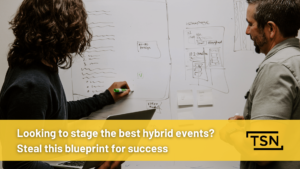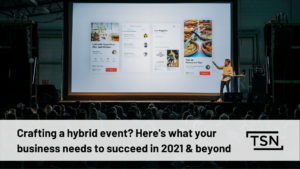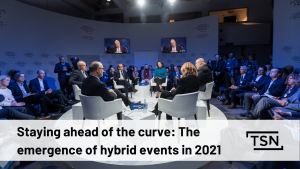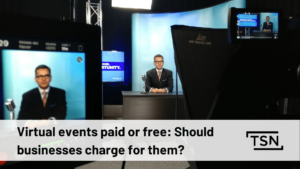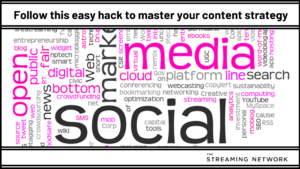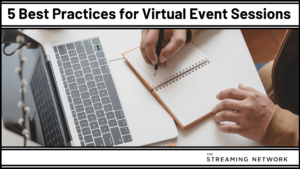Podcast: Play in new window | Download | Embed
Subscribe: Apple Podcasts | Google Podcasts | RSS
Lessons From The Frontline
In our last episode, we discussed the meaning behind personalizing your webinars and its significance.
Part of the discussion touched upon persona-based marketing. In this episode, we will discuss how beneficial it is to leverage webinars with your buyer personas and account-based marketing strategies.
We will be tackling the following topics:
- What do you need to be thinking about in terms of personalization?:Don’t make content that’s meant for everyone.
- How do you keep creating content without reinventing the wheel?: Think segmentation.
- Why keeping your sales CRM updated is important to personalized content?: Curate webinars for every stage of the buyer’s journey.
- How do webinars fit in my personalization strategy?: Leveraging webinars for every persona.
The Complete Video Transcript
Peter Vamos: Webinars are hot. As a content marketing professional, I’ve produced hundreds of videos for social and traditional media platforms, and currently, work with one of the largest podcast networks in the country. So, for me, understanding how webinars work in the B2B space is both essential to my professional development and an exciting form of content creation.
According to a study commissioned by digital agency Demand Wave, 41 percent of B2B marketers cite webinars as the best marketing tactic for driving revenue. I’ve set out to discuss webinars with one of the foremost experts in the field, Matt Ley, President of The Streaming Network in Toronto. Together, we’ve created this multipart series of videos and podcasts, “The Webinar: Lessons From the Front Line” or “How I Learned to Live With Never Getting a Second Chance With Live Virtual Events.”
Welcome back to LFTF. We are sitting here on the–in the hotel room overlooking this lovely beach, and we’re talking about personalization.
Matt Ley: We’re talking about personalization and waiting to go on that beach and have a drink–.
Peter Vamos: –Yes–.
Matt Ley: –There, Pete–.
Peter Vamos: –I can hardly wait.
Matt Ley: Yeah.
Peter Vamos: It’s just sitting there. It’s beckoning us.
Matt Ley: Beckoning us.
Peter Vamos: It’s a little overcast, but still think it’s going to be quite lovely out there when we finally get there.
One of the things we were talking about, and I think sort of central to this–to the whole notion of personalization, is building personas.
Matt Ley: Yeah.
Peter Vamos: That’s kind of key to the whole thing–.
Matt Ley: –Yeah–.
Peter Vamos: –Right? Large enterprise businesses have hundreds of personas. Small operations like Tucker has one persona.
Matt Ley: Right.
Peter Vamos: We, as an organization, have a handful. So–which leads me to ask the question, what do you need to be thinking about in terms of personalization? What do you personalize for?
Matt Ley: Yeah. I mean, it’s the most–well, I think you should personalize for as much as you can. And I say that with a–I think that if we could all give our–like, I said this top of the last one. I’ll say it again.
If we could all give our customers that Google experience, where they get to our website and we know everything about them so we can know exactly how they like to consume it, what they’re looking for and all of that, we would, but we can’t. And we’re–so, I think that you do it for what you can. And you’ve got to look at what you’ve got and where it matters.
If you are doing content for everyone, it’s high level and it’s really for no one. It’s no one person. So, you want to start by, at minimum, ensuring that you’ve got different content for your different buyers’ personas, whether that be your verticals or the type of buyer that’s involved in the decision making process.
If you have a fairly simple buyer or your value proposition is–I don’t–you know what? In B2B, people are talking webinars. I don’t think any one’s simple.
Peter Vamos: Um-hmm.
Matt Ley: There’s a reason why you do webinars. It’s because you cannot, you know, basically sell a product, like, with a credit card and do whatever.
Peter Vamos: Yeah.
Matt Ley: So, I think that everyone here gets that they’ve got multiple people in the buying cycle or buyers’ decision, and they’re dealing with different verticals or users that have different needs.
Peter Vamos: Right.
Matt Ley: And you’ve got to start by ensuring that you’ve got some content around that.
Peter Vamos: Right. Right, and breaking it down accordingly.
Matt Ley: Yeah.
Peter Vamos: Yeah.
Matt Ley: And so, getting good at being able to create content that way is–I think is important.
Peter Vamos: Um-hmm.
Matt Ley: Coming up with strategies to make it easy when you’re got a new thing happening. How do you create the pieces of content without reinventing the wheel? So, that is important.
On the flip side, how good is your data? You know, there are some small companies out there–we don’t happen to be one of them, but there’s some small companies out there that have been great with data from day one because they’ve known the importance of it.
Peter Vamos: Um-hmm.
Matt Ley: And they can segment it down to all kinds of different levels. And if you’re able to do that, then you are able to go directly into depersonalization. So, I think you should personalize as much as you can, basically.
Peter Vamos: In terms of the–like, you need data. You need the technology, right? Like, that’s sort of part of it, pulling–like, what do you need?
Matt Ley: Well, I mean, I think–I mean, if you’ve got the content–.
Peter Vamos: –Um-hmm–.
Matt Ley: –Let’s just assume you’ve got content that you can reach.
Peter Vamos: Sure.
Matt Ley: If you’ve got a CRM that’s packed, like, with the information that you need, a good tracking, a good discipline by your sales force, so understanding where people are in sort of the journey, and up to date information and a marketing automation system, I think that’s enough to start personalization–.
Peter Vamos: –Um-hmm–.
Matt Ley: –Right? So, you can easily segregate everyone with at @oracle.com email address and start campaigning to them in a–with content that makes sense for what’s going on in that.
You can easily pull the names and the emails of people who are, you know, at the–perceived to be at the decision making stage or evaluation stage and–because they’ve got a demo of your platform or they’ve got a proposal in front of them by a sales rep and you know what content you want to have in front of them at that point in time. And because your–and you’ve got a marketing automation platform integrated, you also kind of know what content they’ve already consumed so you can send them stuff that they haven’t. So, you can start, I think, with that.
That’s more segmentation not–maybe not all that personalized, but that is a start. The tools that are out there, like Drift, that are meant for depersonalization or account-based marketing stuff, they make it easier.
Just like I say to everyone, every tip we give you about webinars on our webinars–on our better webinars, as we used to call them–.
Peter Vamos: –Um-hmm–.
Matt Ley: –Or on this thing or whatever, can be done with any tool out there.
A bunch of free ones mashed together could do it probably. It’s just going to be a lot easier with our platform–.
Peter Vamos: –Right–.
Matt Ley: –Generally, right?
It’s the same thing with all this tech. It’s not–it is way better than not having it.
Peter Vamos: Right.
Matt Ley: Whether or not it’s worth the dollars to you, it doesn’t–that’s not my call. But it’s way better than not having it, and it’ll make it a lot easier for you.
So, I think you’ve got to figure out where you’re at and make a plan for it, right? I think we’ve all had to take a long, hard look at ourselves and understand that we’re–you know, with–as marketing has become so much more important, I know we have–.
Peter Vamos: –Um-hmm–.
Matt Ley: –We realized that, you know, we had to get our data game tighter. We got to get our content game, you know, more diversified.
Peter Vamos: Yeah.
Matt Ley: We can’t be so broad-based with everything that we do. And then go out and make a plan to kind of do it.
And you can’t–and so, CRM marketing automation is a bare minimum. And then, from there, people would go what other little tidbits.
Peter Vamos: Right.
Matt Ley: You would pull that in, I think.
Peter Vamos: A good webinar platform obviously helps. You do a good webinar program, you do–like, even if it’s not a targeted one, you can certainly bring–.
Matt Ley: –Yeah. I don’t want to make it a sales pitch, but–.
Peter Vamos: –No, no–.
Matt Ley: –Yeah–.
Peter Vamos: –I’m just saying, like, those are the other sorts of things, right?
Matt Ley: Yeah. I mean–.
Peter Vamos: –This is all a sales pitch. We’re doing a podcast on webinars.
Matt Ley: Yeah, I know. It’s not leadership, Pete. You’ve told me this many times. But no, but–okay, let’s just–let’s talk about that for a second.
Peter Vamos: Okay.
Matt Ley: You’re right. Is–yes, in this case, all the stuff we’ve been talking about around personalization you literally cannot do with GoToWebinar.
Peter Vamos: Yeah.
Matt Ley: Sorry, guys. Like, you literally cannot. And that’s not about the data or the integration side. It’s just about the way the tool is structured–.
Peter Vamos: –Yeah–.
Matt Ley: –Is that you cannot take a webinar you ran yesterday, rebrand it up, get it out to this person, change it in the ways that you can with the tool that we offer–which I won’t say the name–or a bunch of other tools that are out there that are more expensive than Go to Webinar–.
Peter Vamos: –Yeah–.
Matt Ley: –Right? So, all the stuff that we’re saying you could look to do there. And you know what? I shouldn’t say you can’t.
I am always impressed with what people are able to do with that tool with the right mindset and the right technology around with it.
Peter Vamos: You need other pieces of technology.
Matt Ley: Yeah.
Peter Vamos: Yeah.
Matt Ley: But, I mean, it’s not like what we’re talking about–.
Peter Vamos: –Yeah–.
Matt Ley: –Like click a button and get it out to this group and do whatever.
Peter Vamos: And know what everybody’s doing and all that–.
Matt Ley: –Yeah–.
Peter Vamos: –Other sort of–.
Matt Ley: –That’s–hey, that’s–isn’t that what all marketing technology is? It’s generally a way for us to do the things that–we need to do it en masse. So, if we want to personalize content or create an account-based marketing system, we want a tool that allows us to do it very easily and very quickly.
Peter Vamos: Right.
Matt Ley: When Microsoft recognized the–they recognized the difference–I keep going back to that use case, but they recognized what was going on only when they deployed Marketo and Daily (sp) Webinar platform together, and they’re like, “Oh.” That’s why they went from 200 to 4,000 webinars.
Peter Vamos: Right.
Matt Ley: It wasn’t that the–I don’t think it had to do with–well, it had to do with how easy it was to produce, how easy it was to enact their strategy. But, it started off with say, “Oh my God, we need to be doing more of these webinars in this way, and this is how we’re going to do it.”
Peter Vamos: Right.
Matt Ley: And they couldn’t have done that in their old tool, or any tool that they make, for that matter.
Peter Vamos: Right.
Matt Ley: So, technology does have a lot to play in getting super personal. But you can have all the technology in the world, if you don’t have the data right–.
Peter Vamos: –Yeah–.
Matt Ley: –Or any sort of content or anything to say to these people–.
Peter Vamos: –Yeah–.
Matt Ley: –Then it doesn’t matter–.
Peter Vamos: –Yeah–.
Matt Ley: –Right? So, you got to put your order of operations in there.
Peter Vamos: And at the end of the day, it’s still–the persona that you’re building around your client is kind of core to the whole thing. The technology obviously helps build it. But if–you need to know who your buyer is and what they need to know and what you’re trying to tell them and all those other things.
Matt Ley: Yeah.
Peter Vamos: Let’s talk about webinars and how webinars fit into this whole paradigm, because that’s sort of, you know, the meat of–.
Matt Ley: –Yeah.
Peter Vamos: We’ve talked a little bit about it. We talked about it in the last episode as well, but let’s get into it. Like, how does–like, how do–how does this work in the world of webinars?
Matt Ley: Quite simple. So, for live, you know, it’s about hitting them with the right message at the right time, the same webinars that always perform well for people at whatever stage of the buyers’ journey. You want to make sure that people who are at that stage are getting invited to that webinar, whether it’s live or it’s on demand. That’s the content that you want them to see. And so, basically customizing when someone’s invited to what type of webinar is how you start that process.
When creating a webinar around account-based marketing or creating a webinar around any of this–like, if today we are doing this about–like, even what we’re doing today goes against this, right? We’re talking–I’m talking–I’m throwing out financial services, I’m throwing out this, I’m throwing out that, right?
But, if I was really committed to this, we would be doing this–and if I actually knew the answers to the questions, because I don’t–.
Peter Vamos: –Yeah. Yeah–.
Matt Ley: –We would actually be talking about personalization for financial services, legal, life science, and technology, our four pillars of our business, and we would have points and stats on them. We don’t.
This is new. We’re not–I’m not, by any stretch, an expert on personalization. I am seeing how my customers are utilizing it for webinars. But that’s how–that’s what I would do. And I would produce all of that content at one point in time so that I was able to ensure that, as I was going out, I had this piece for each of my various personas that are in it. So, yes, webinars fit there.
And then, the other thing is that on demand, right? So, when creating a customized content experience for a persona or a company or anything that you’re doing from a personalization perspective, a webinar is a great thing to have in there, just simply due to the time invested in watching one and the general knowledge that they’re–that person is vested in you and your offering. And so, they’re always–I have never been–I have never seen a ABM-based content experience that does not have a webinar in some capacity in it–.
Peter Vamos: –Right–.
Matt Ley: –Because it’s the easiest thing to kind of do.
And then finally, this way we do things is to create our good content, we think.
Peter Vamos: Yeah.
Matt Ley: Right?
Peter Vamos: Yeah.
Matt Ley: Video–.
Peter Vamos: –Oh, like–.
Matt Ley: –It’s high quality and it’s all of that. But, generally speaking, most people think of a webinar–and it’s true. It’s easy to create. It’s a PowerPoint. It’s–you dial in or you turn on your webcam or whatever it is, and you’re creating it. So, as you start talking about creating, you know, personalized content, what’s easier to do than that?
You’re not booking a studio. You’re not writing anything. You’re not–you’re just, you know–you’re just going–.
Peter Vamos: –Um-hmm–.
Matt Ley: –Basically, and it’s a presentation that you’ve probably given a bunch of times on the–as a sales person or whoever it might be. So, it can fuel it because it’s an easy content creation tool, right?
So, wherever your gaps are, you can use your webinar to fill those gaps and really go–you know, get customized within it.
Peter Vamos: Right, right, right. Excellent.
Let’s talk about some real world examples.
Matt Ley: Sure.
Peter Vamos: What sort of–what sorts of real work examples can you point to when we’re talking about this sort of stuff?
Matt Ley: Well, as it relates to webinars and that sort of thing, I can actually–I will use a financial services, which is weird. We never–don’t usually have the relevant one.
But, you know, a company that manufactures mutual funds has got a couple key distribution channels, and so they run a webinar with a thought leader. And whenever they run it, they run it with different branding on it, different times for different distribution channels, because there’s a slightly different message at the end.
I forget what the reason for it is. But they do it, and they put that person’s logo front and center and the thought leader only gets to speak once. And it’s something they’ve been doing for a very long time. And so, they’re customizing their content experience for their various channels for many reasons.
But, they’re–they’ve been doing it. And we’ve been part of that for some time and seen that sort of spread out as well where, when it’s on demand and people are coming to get content from them because their distribution channels are, like, really big–well, they’re like wholesalers, right, like, really big customers. And so, when they’re coming to get their–coming in to get there, they have some say in “We don’t want our people seeing this.”
And so, they’ve started to create the experiences for these massive channels when they come in and grab their content, and that includes branding, type of content, and really the messaging they want to have in front of those people.
Peter Vamos: Right.
Matt Ley: And so, oftentimes when we’ve been involved in personalization, I think it’s been done–like everything, it’s done because it’s needed.
And now that we’ve–we–that has been going on for years. Now what we’re seeing is that basically, as it’s becoming more of a forefront of marketing, is that the tool itself is really easy to be a part of that. So, what I mean is it’s easy to re-skin. It’s easy to rebrand. It’s easy to slightly change what it is that someone is seeing.
And so, what is–so, some real world examples of that are, you know, companies that will run a webinar through different, like, publications, right? The same one will go out, like, seven different places.
Peter Vamos: Um-hmm.
Matt Ley: So, one piece of content, one message, and they keep driving leads on it. It’s more of a repurpose edit as a–than it is a personalization.
Peter Vamos: Although targeted–.
Matt Ley: –Targeted, yes–.
Peter Vamos: –To each group, right–?
Matt Ley: –Yeah, exactly–.
Peter Vamos: –Which is the–yeah–.
Matt Ley: –Targeted to each group.
And then the personalized experience side of it is the big one, where, you know, content hubs and content experiences with webinars and clips from webinars are being developed for companies and for everyone within the platform now. And that’s what we’re getting asked more and more and more about.
And what was neat and fun was, you know, seeing this when we were at Webinar World, you know, and understanding that, because we sit behind the marketing automation tool quite often or the CRM, so that data’s all there. So, when you register–because people who come to webinars are generally known to that person in some capacity. They’ve been invited, right? When you come in, now that we know that, what can we do?
We can launch a different webinar for you and for me because we’re at different points in the–.
Peter Vamos: –Right–.
Matt Ley: –Buyers’ journey–.
Peter Vamos: –Right–.
Matt Ley: –Or we’re at different levels of seniority or you’re in this industry and I’m in that industry. So, we can do a broadcast–or a marketing piece on data and, you know, data-driven webinar success stories, and you can see something that’s completely different than what I can see.
Peter Vamos: Right.
Matt Ley: The calls to action, the resources, whatever’s involved could be completely different as well.
So, it’s–I think that what you’re going to find is, as your own personalization needs grow and as you’re looking to provide personalized experiences, is that you are going to end up at the webinar anyways because it’s an easy way of doing it, and it actually has built into it this ability that a lot of the other tools maybe don’t have.
Peter Vamos: Right.
Matt Ley: Right? So–.
Peter Vamos: –Interesting. If you’re–and this is great. If you’re got a lot of content, if you’ve got a decent amount of content, you know who you’re targeting–.
Matt Ley: –Yeah–.
Peter Vamos: –And have built around that, the path is clear. And the way you’ve described has been, you know, very well articulated.
If you’re a person just starting out, if you’re a business just starting out, like, how do you start? Where would you start on personalization? What’s the first steps you take?
Matt Ley: I don’t know. I mean, I think that you–with anything that you’re doing, you want to start with where the money is, right? So, if you’ve got a product that speaks broad-based and everyone can use it, but you know that–I don’t know–technology companies are your bread and butter–.
Peter Vamos: –Um-hmm–.
Matt Ley: –You start personalizing content for technology companies. You start creating a vertical practice.
That is what happened within our organization with financial services. Before we did any other vertical, we did that because we had a practice emerging. We had revenue. We had a rep that was focused on it, and that’s why we started doing, you know, basically personalized content for a section of the Canadian financial services market.
As a result, we, you know, have, you know, gained, like, 85 percent of that market and are taking those learnings and moving them into other verticals, which has worked really well for us now because the technology’s advanced in such a way.
So, I would start by personalizing where you know, you think the money is, or where you want to be. And depending on how just starting out you are–I mean, you know, that’s an interesting question too about content comes first or whatever it might be, but that’s where I would definitely start.
Peter Vamos: So, pick your vertical, pick your persona, start to create content–.
Matt Ley: –And start to create content–.
Peter Vamos: –For that person–.
Matt Ley: –For that. So, you’ve got your base content–.
Peter Vamos: –Yeah–.
Matt Ley: –And then that person’s content. And then from there, as you get into it, like anything, it gets easier, right?
Peter Vamos: Yeah.
Matt Ley: You start flexing that muscle. You start learning the machine like we’ve–that–like we’ve learned. And it gets easier to create the content and deliver the content the more that you do it.
Peter Vamos: Right.
In terms of the things you need–and this is the last question–but the things–.
Matt Ley: –Yeah–.
Peter Vamos: –You need to get started–I mean, obviously you need to be able to build a persona. You need to have done some reading and some research. How do you get started? What sorts of things do you need?
Matt Ley: Well, you need to know who it is that you’re going after. You need to be able to identify them in some capacity within your CRM or in lists, I guess, that you acquire or in your advertising or whatever it might be.
You need content that speaks to them, and that content can be the–you know, you know the language, put pieces in front of them. And you need to understand, you know, your delivery mechanism and what is going to be the best for it, right?
And so, sometimes, you know, it’s all advertising-based, right? You’re trying to get in front of people that you can’t get in front of on your own. In other cases, it’s based around your existing data. So, there are a few things that kind of are required.
But, like, we all got to remember 10 years ago almost none of us had a clean database or much of a database to speak of. None of us had a marketing automation platform, really. We had an email platform. And none of us were talking about this level of personalization. We were trying to figure out how to automate the personalization that was happening by the sales people and by the people that were front of house.
Peter Vamos: Um-hmm.
Matt Ley: So, we’ve gone full circle now. We know how to do it. Whether or not, you know, you’re getting started or not, you know how to personalize. You were doing it before all of this.
Peter Vamos: Right.
Matt Ley: Right? So, go back, remember that, think about that, and then look at what tools you have to kind of work that back in.
Peter Vamos: Right. Very good.
We did it in 20 minutes.
Matt Ley: We did it in 20 minutes.
Peter Vamos: Matt, thank you so much.
Matt Ley: Thank you, Peter.
Peter Vamos: This has been–I believe this would have been episode 14.
Matt Ley: Fourteen.
Peter Vamos: This is 14.
Matt Ley: Wow.
Peter Vamos: Yeah, “Lessons From the Front Line” or, as like to call it, LFTF.
Matt Ley: Thanks so much, Peter.
Peter Vamos: It’s been a great, great conversation, once again around personalization. Part one is also online. And that is that. That is the world of webinars as we see it.
Matt Ley: Let’s go get a drink.
Peter Vamos: Let’s go get a drink.

